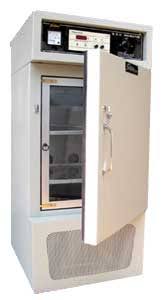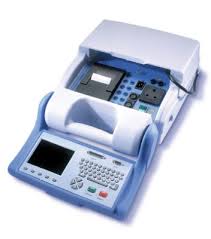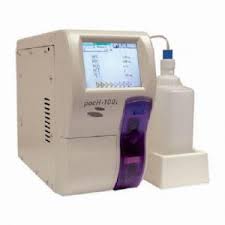Monday, July 26, 2010
Spectrophotometer

Sunday, July 25, 2010
Centrifuge

Thursday, July 15, 2010
Thursday, July 8, 2010

Microbiology (from Greek μῑκρος, mīkros, "small"; βίος, bios, "life"; and -λογία, -logia) is the study of microorganisms, which are unicellular or cell-cluster microscopic organisms.[1] This includes eukaryotes such as fungi and protists, and prokaryotes. Viruses, though not strictly classed as living organisms, are also studied.[2] In short; microbiology refers to the study of life and organisms that are too small to be seen with the naked eye. Microbiology typically includes the study of the immune system, or Immunology. Generally, immune systems interact with pathogenic microbes; these two disciplines often intersect which is why many colleges offer a paired degree such as "Microbiology and Immunology".
Microbiology is a broad term which includes virology, mycology, parasitology, bacteriology and other branches. A microbiologist is a specialist in microbiology and these other topics.
Microbiology is researched actively, and the field is advancing continually. It is estimated only about one percent of all of the microbe species on Earth have been studied.[3] Although microbes were directly observed over three hundred years ago, the field of microbiology can be said to be in its infancy relative to older biological disciplines such as zoology and botanyWednesday, July 7, 2010
Monday, July 5, 2010
Molecular Structure of Bacteria
Molecular Structure of Bacteria
1- Cell Membrane:
It is very important structure in the bacterial cell, also called cytoplasmic membrane or sometimes protoplasmic membrane. Chemically cytoplasmic membrane is composed of bilayers of phospholipids.
Basic functions of cell membrane are :
1\ to control the movement of substances.
2\ to secrete hydrolytic enzymes.
3\ responsible for secretion of transport protein and proteins involved in cell wall synthesis.
2- Cytoplasm: which contains:
3- Genetic Material: a single piece of DNA without nuclear membrane.
4- Ribosomes: which are known as protein making organelle.
5- Mesosomes: Which are attached to the cell membrane and is thought that it is associated in cell division (binary fission).
6- Cell Wall: is another component of bacterial cell which is outside the cell, it is a rigid organelle and also it gives the bacteria it's shape and also prevents expansion of cell membrane (protects the cell against osmotic pressure). The other name of the cell wall is known as peptidoglycan which is composed of: polysaccharides: the main polysaccharides which are found in the composition are:
- N – acetyl glucose amine.
- N – acetyl muramic acid.
and this peptidoglycan is only found in the cell wall of bacteria. It is a target for antibiotics to act on. Some antibiotics act on the cell wall e.g. penicillins and cephalosporins. This is known as selective toxicity.
Differences between G+ve and G-ve bacteria:
| | Gram +ve | Gram –ve |
| 1- | Cell wall is thick | Cell wall is thin |
| 2- | Cell wall is compact | Cell wall is less compact. |
| 3- | Cell wall almost is peptidoglycan which includes 90% | Cell wall is peptidoglycan but only 10% |
| 4- | Contains a component of teichoic acid in the cell wall | No teichoic acid. |
| 5- | Presence of lipoteichoic acid | No lipoteichoic acid |
| 6- | Cell wall cotains No lipo polysaccharide | Cell wall contains lipo polysaccharides |
| 7- | The surface is made of protein | The surface is made of: lipo polysaccharides, lipo protein, phospholipids. |
Defect or obstruction of the cell wall will give:
1- Protoplast
2- Spheroplast
3- L-forms
Specialized products outside the cell wall:
1- Capsule:
this is a layer of loose slime material which surrounds some bacterial cells. The capsules are composed of mainly of polysaccharides or peptides. They resist phagocytosis and so their presence on a bacterium is associated with virulence. They are identified by negative staining due to their low affinity for simple staining.
* e.g. of capsulated bacteria:
Klebsiella pneumoniae (polysaccharide)
Bacillus anthraces (poly – D – glutamic acid)
2- Flagella:
These are filaments that originate from the cytoplasm. They function as organs of motility. They are therefore seen only in organisms that are motile. They are made of protein (Flagellin).
The functions of flagella are:
1- motility (mainly)
2- attachment to site of infection e.g. stomach.
3- Diversity of antigens, this is used for diagnosis and this is mainly in Salmonella typhi (the causative agent of typhoid fever).
4- Invasion.
5- Colonization (form colony).
3- Pili:
Pili are divided into two groups:
1- Sex pili, referred to as sex pili because of their role during conjugation when genes are transferred from one cell(donor) to another cell (recipient).
2- Common pili, or Fimbriae: these are thought to be the organs of adhesion that help bacteria to attach to the host cells (Virulent Factor).
4- Spores:-
These are dense structure produced by some bacteria, e.g. the Bacilli and Clostridia groups, that enable them to survive adverse environmental conditions. They develop within and at the expense of the vegetative cell. The spore comprises the chromosomal material surrounded by several walls layers.
Chemically, endospore has a large amount of Ca++ and less number of enzymes. Dpiclonic acid is also presents in spore.
Spores are resistant to heat, stains, desiccation, chemicals and disinfectants.
Each spore germinates to produce a vegetative cell during favorable conditions.
The location and shape of the spore in the cell may be of diagnostic assistance, e.g. the spores of Clostridium tetani are terminal, and the diameter is greater than that of the parent cell, so that they are characteristically of drum stick appearance.
The positions of the spores are described as:
Terminal , Sub terminal , or Central
Bacterial Growth Requirement
Bacterial Growth Requirement:-
Cultivation of Bacteria:
Culturing of Bacteria:
Culturing is a technique used to isolate a microorganism in a pure culture and used for testing the sensitivity to an antibiotic i.e. to determine the suitable antibiotic for certain microorganism.
e.g. to isolate organism from a specimen, you need culture media, then inoculate the specimen (e.g. urine) by a needle in a zigzag form, then incubate at temperature 37˚C, after 24 hours you see organism growing in pure form, i.e. you found only one type, otherwise it is mixed.
The medium of culturing must contains:
1- Carbon source: carbohydrate, organic salts
2- Nitrogen source: peptone = Digestive protein. Amino acids
3- Essential vitamins (growth factor)
4- Minerals (growth factor)
5- Essential amino acids: in meat extract(beef).
- These ingredients are dissolved in distilled water, the pH is adjusted to 7.2 and then the medium should be sterilized (e.g. by Autoclave).
- Medium is either solid or liquid and some times semisolid.
Solid medium: used for isolation in pure form.
Friday, July 2, 2010
 Foxboro Analytical - Model Miran 1B2 Ambient Air Analyzer, battery operated, microprocessor controlled single beam infrared analyzer capable of monitoring for over 100 precalibrated compounds. Measures organic and inorganic compounds which absorb infrared energy in the 2.5 - 14.5 micron region. Can be user calibrated to additional compounds or different ranges. Weighs 30 pounds. Scanning capability for quantitative analysis. LCD display. Adjustable pathlength gas cell. Four hour battery. Includes: Instrument, zero cartridge, sampling wand with filter, charger, battery pack, case, manual, and cables
Foxboro Analytical - Model Miran 1B2 Ambient Air Analyzer, battery operated, microprocessor controlled single beam infrared analyzer capable of monitoring for over 100 precalibrated compounds. Measures organic and inorganic compounds which absorb infrared energy in the 2.5 - 14.5 micron region. Can be user calibrated to additional compounds or different ranges. Weighs 30 pounds. Scanning capability for quantitative analysis. LCD display. Adjustable pathlength gas cell. Four hour battery. Includes: Instrument, zero cartridge, sampling wand with filter, charger, battery pack, case, manual, and cables
Mettler LC-P45 Balance Printer
 Mettler - Model LC-P45 Impact Balance Printer with RS232 Connection
Mettler - Model LC-P45 Impact Balance Printer with RS232 Connection
Orion Research EA 940 pH / ISE Meter
 Orion Research, Inc. - Model EA 940 pH/ISE Meter, 110V, 50/60 Hz
Orion Research, Inc. - Model EA 940 pH/ISE Meter, 110V, 50/60 Hz
Finnigan LCQ Mass Selective Detector
 Thermo Finnigan - LCQ Mass Selective Detector
Thermo Finnigan - LCQ Mass Selective Detector
Finnigan AQA single quadrupole mass spectrometer
 Thermo Electron/Finnigan - Finnigan AQA single quadrupole mass spectrometer detector for coupling with Dionex HPLC and high performance IC systems, for the first ever IC/MS capabilities. The AQA is capable of switch-able dual atmospheric pressure ionization sources. Electrospray ionisation and atmospheric chemical ionisation are available for LC and IC applications. IC/MS System comes with Dionex IC25 Pump and Conductivity Module, Dionex LC30 Chromatography Oven, and Dionex AS50 Autosampler. Xcalibur Computer data system included on new computer and flat screen monitor. System can be utilized for IC/MS or Standard IC operations. System is Refurbished, Tested, and Sold with a Full Six-Month Warranty
Thermo Electron/Finnigan - Finnigan AQA single quadrupole mass spectrometer detector for coupling with Dionex HPLC and high performance IC systems, for the first ever IC/MS capabilities. The AQA is capable of switch-able dual atmospheric pressure ionization sources. Electrospray ionisation and atmospheric chemical ionisation are available for LC and IC applications. IC/MS System comes with Dionex IC25 Pump and Conductivity Module, Dionex LC30 Chromatography Oven, and Dionex AS50 Autosampler. Xcalibur Computer data system included on new computer and flat screen monitor. System can be utilized for IC/MS or Standard IC operations. System is Refurbished, Tested, and Sold with a Full Six-Month Warranty
 Dionex Corporation - DX120 Ion Chromatograph System Including: Dionex DX120 Ion Chromatograph, Dionex AS40 Autosampler and Dionex Peaknet 5.21 Computer Data System with New Computer and Flat screen Monitor. System is Refurbished, Tested, and Sold with a Full Six-Month Warranty.
Dionex Corporation - DX120 Ion Chromatograph System Including: Dionex DX120 Ion Chromatograph, Dionex AS40 Autosampler and Dionex Peaknet 5.21 Computer Data System with New Computer and Flat screen Monitor. System is Refurbished, Tested, and Sold with a Full Six-Month Warranty.
medical laboratory equipment
 HP/Agilent - Model Agilent 1100 HPLC System Including: 1100 Quaternary Pump, 100 Position Autosampler, Variable Wavelength UV-VIS Detector, Column Module, Solvent Module, Pentium IV Computer, ChemStation Software - Tested and Recondition System with Six (6) Month Warranty. Installation and Training Options are Available. Other Pump, Detector and Autosampler Options are Available. Call us to Review a Custom Configuration and to Obtain an Instrument Specific Price Quotation.
HP/Agilent - Model Agilent 1100 HPLC System Including: 1100 Quaternary Pump, 100 Position Autosampler, Variable Wavelength UV-VIS Detector, Column Module, Solvent Module, Pentium IV Computer, ChemStation Software - Tested and Recondition System with Six (6) Month Warranty. Installation and Training Options are Available. Other Pump, Detector and Autosampler Options are Available. Call us to Review a Custom Configuration and to Obtain an Instrument Specific Price Quotation.






































